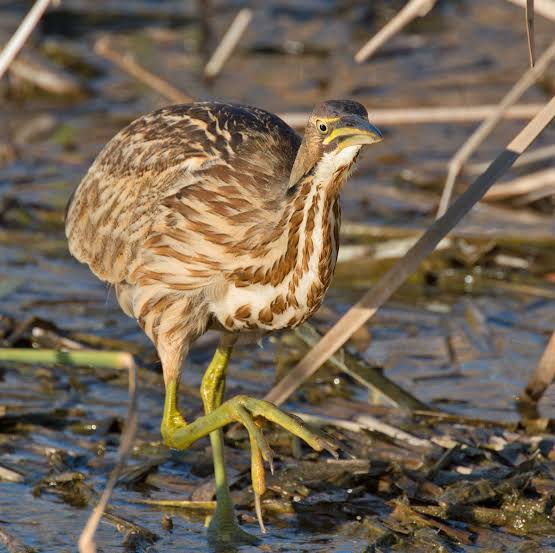The American bittern (Botaurus lentiginosus) is a species of wading bird in the heron family. It has a Nearctic distribution, breeding in Canada and the northern and central parts of the United States, and wintering in the U.S. Gulf Coast states, all of Florida into the Everglades, the Caribbean islands and parts of Central America. Adult American bitterns are large, somewhat stocky birds with yellow eyes, rich brown upperparts, and a white throat that is offset by black streaks. Dark flight feathers are conspicuous on the wing tips when the birds are in flight. The sexes are similar in appearance. American Bitterns stand still at the edge of the water, sometimes walking slowly. Like most herons, they capture prey with sudden thrusts of their bills. They are most active at dawn and dusk. American Bitterns breed mainly in freshwater marshes with tall vegetation. You can find them in wetlands of many sizes and kinds, typically less densely vegetated and shallower than wetlands used by the Least Bittern. In winter they move to areas where water bodies don't freeze, especially near the coast, where they occasionally use brackish marshes. Managed wetlands such as wildlife refuges seem to be important for wintering American Bitterns. Wintering birds may also forage in dry grasslands and other terrestrial habitats. American Bitterns eat insects, crustaceans, fish, amphibians, reptiles, and small mammals. Their most common insect prey include water striders, giant water bugs, water beetles, water scorpions, grasshoppers, and especially dragonflies, which the birds sometimes manage to capture in midair. Frequently consumed fish include eels, catfish, pickerel, sunfish, suckers, perch, killifish, and sticklebacks. Rayfish, crabs, frogs, tadpoles, salamanders, garter snakes, water snakes, and meadow voles round out the diet. American Bitterns usually forage in dim light, at shorelines and the fringes of vegetated areas. A foraging bird may sway its neck, perhaps to see past glare from the surface of shallow water, or to warm up its muscles for a quick strike. A characteristic strategy is to stand stock-still with bill held horizontal, gradually aiming the bill downward with nearly imperceptible movements—until, with a sudden darting motion, the bittern seizes the prey in its bill, bites or shakes it to death, and swallows it head first. Indigestible parts of prey animals are regurgitated as pellets. Little is known about the predators of American bitterns. Raccoons probably feed on their eggs and chicks on occasion. Adults may be preyed on by peregrine falcons and great horned owls. To communicate with each other through dense vegetation American Bitterns use low-frequency calls, which carry farther than higher-pitched sounds. During breeding season the males make a bizarre, resonant three-syllable pump-er-lunk call with a liquid quality; females may respond with a similar but quieter sound. The male’s call is preceded by clacking and gulping. To accomplish the pump-er-lunk sound, the male inflates his esophagus by way of almost violent body contortions—opening and closing his bill as if lunging for flying insects—and then uses the stored air to unleash his call. Repeated up to 10 times in succession, the call probably serves as both a territorial signal and an advertisement for mates. When flushed, American Bitterns often emit a hoarse kok-kok-kok or nasal haink. Males may give a continual chu-peep call during mating. Bitterns clack the mandibles of their bills together to make sounds preceding their territorial call. Here is a link so you can listen to this bird too.
